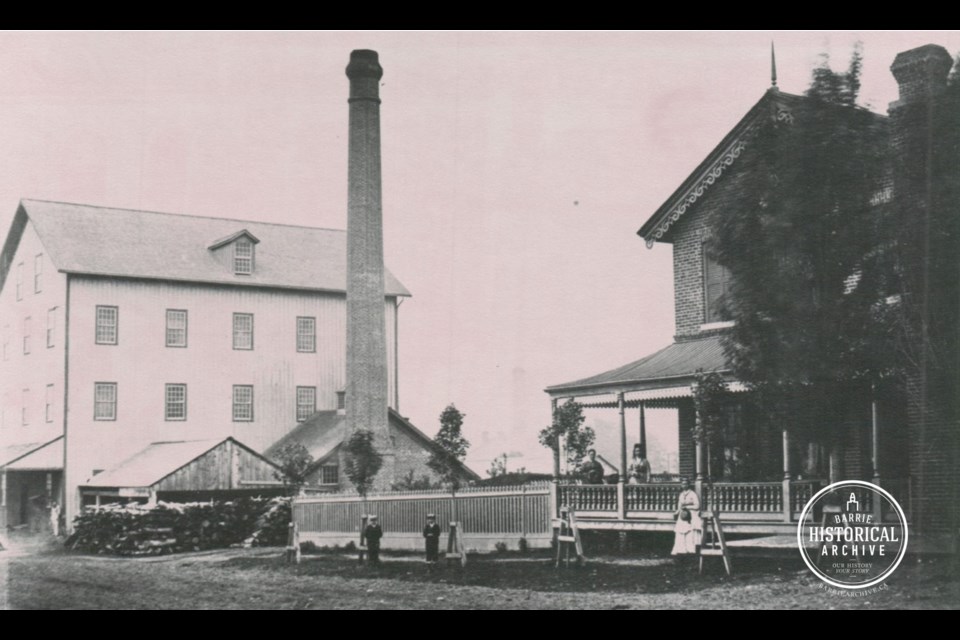The blocks, lots and intersections of this town have been changing since this community was carved out of the woods. Dirt paths became streets. Hastily built wooden structures were converted to brick. People came and Barrie’s perimeter spread out in all directions.
That is the natural progression of a successful urban area. Less fortunate communities fail to grow. Some turn into ghost towns when their industry is lost or the major route of transportation bypasses them.
Along with planned improvements, Barrie has experienced a number of unintended changes, many of them as a result of the destructive fires that occurred often here over the years.
This is a look at just one block. It has been the site of quite a few drastic changes and is undergoing another big one right now.
On the southwest corner of Dunlop Street West and Maple Avenue stands the last remaining remnant of the 1800s in that section. What many long-time Barrie residents remember as Roy Lem’s restaurant was originally M.H. Spencer’s Tea Store.
This is actually one of the very oldest business buildings in downtown Barrie, although it’s difficult to detect today. M.H. Spencer had his brick store built in 1867, one year after the still-standing McConkey building on Dunlop Street East that houses McReilly’s Pub.
What they have in common is fire proofing. Both Spencer and McConkey were keenly aware of the spectre of fire that continually stalked the downtown and so constructed their places of business accordingly.
The Spencer building stood alone as a place of business for many years. Behind it, to the south, stood James Wilkinson’s fine house. This was the home of the man who owned the grist mill, which was located approximately where our present bus station sits.
With no fast-flowing streams nearby, Barrie lacked a mill and residents had to take their goods out of town to be processed. Steam mills, a rather new innovation in 1867, required a great deal of firewood, but that was no problem for lumberman Allan Gunn, who had it built. His problem was cash and, a year after the mill’s construction, it was sold to James Wilkinson.
The Wilkinson mill burned down in 1918 and was rebuilt within a few months. In 1952, that mill burned down as well, thus ending 85 years of that industry on that site.
Before that last version of the mill was destroyed, other changes had been taking place in the vicinity. In 1923, R.F. Garrett purchased most of the Wilkinson property that fronted on Elizabeth Street, which is now Dunlop Street West.
Garrett’s plan was to build a moving picture house and an automobile garage. These were bold and modern proposals at the time and not locally popular. Those running the Grand Opera House and the Dreamland silent movie theatre were particularly unhappy.
From the demolition of the old Wilkinson house to the grand opening of the Capitol Theatre next door to the former Spencer store, only 10 weeks passed.
The new auto garage west of the theatre was first operated by Fred VanPatter. His business partner was Harold Hill, who later moved along the block to open his own garage.
At nearly the same time, Charles Robinson opened his first hardware store in the old Spencer store. Robinson, Garrett and VanPatter didn’t necessarily get along, so Robinson eventually moved his business to 31 Dunlop St. E.
VanPatter died suddenly in 1934 and Garrett expanded his theatre business into the former garage and opened the first version of the Imperial Theatre in 1937. This was quite the theatre district by then as the Roxy had been built across the street just short of a decade earlier.
Farther down the street, at 47 Elizabeth St., another business of the modern age appeared – the first funeral parlour in Barrie. Oscar Reid partnered with Percy Lloyd until Lloyd took over completely in 1923. In turn, Lloyd took a partner called Walter Steckley, a name still well known today.
As for the former mill site on Maple Avenue, the Valley family held the property for many years and used it for their fleet of buses and taxis.
When the bus terminal on the east side of Maple Avenue outlived its usefulness, a new terminal was constructed on the old mill property in 1992.
Only the former Spencer Tea Store and Capitol Theatre building remain. The rest of the block has been demolished as Phase 1 of a two-tower condominium project rises from the ground. Some 30-plus storeys of steel and glass will soon soar above downtown.
Each week, the Barrie Historical Archive provides BarrieToday readers with a glimpse of the city’s past. This unique column features photos and stories from years gone by and is sure to appeal to the historian in each of us.



